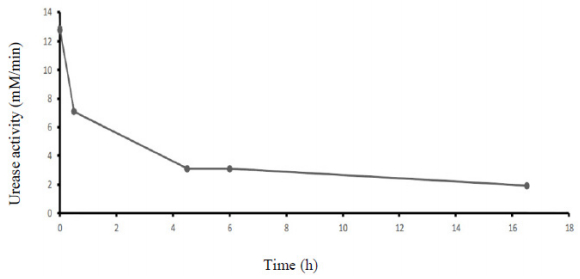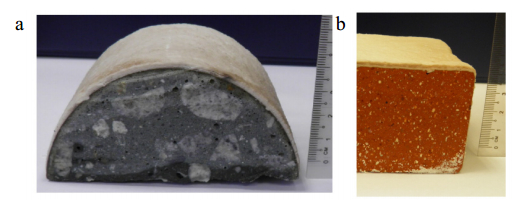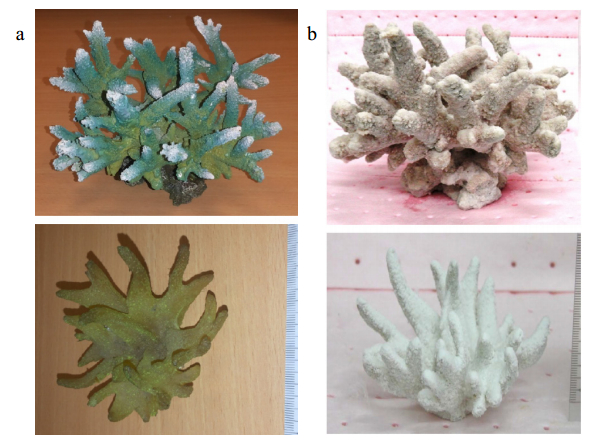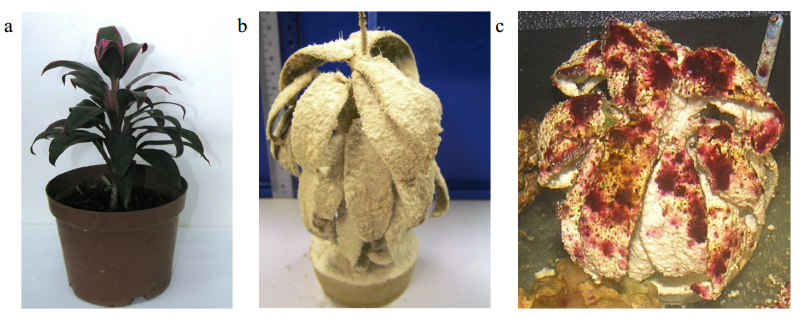Natural formation of the coral reefs is complicated by slow biomediated precipitation of calcium carbonate from seawater. Therefore, manufactured artificial coral reefs can be used for the formation of “underwater gardens” in marine parks for the recreational fishing and diving that will protect natural coral reefs from negative anthropogenic effects. Additionally, the coating of the concrete, plastic or wooden surfaces of artificial coral reef with calcium carbonate layer could promote attachment and growth of coral larvae and photosynthetic epibiota on these surfaces. Three methods of biotechnological coating of the artificial coral reefs have been tested: (1) microbially induced calcium carbonate precipitation from concentrated calcium chloride solution using live bacterial culture of Bacillus sp. VS1 or dead but urease-active cells of Yaniella sp. VS8; (2) precipitation from calcium bicarbonate solution; (3) precipitation using aerobic oxidation of calcium acetate by bacteria Bacillus ginsengi strain VSA1. The thickness of biotechnologically produced calcium carbonate coating layer was from 0.3 to 3 mm. Biocoating using calcium salt and urea produced calcite in fresh water and aragonite in seawater. The calcium carbonate-coated surfaces were colonized in aquarium with seawater and hard corals as inoculum or in aquarium with fresh water using cyanobacteria Chlorella sorokiana as inoculum. The biofilm on the light-exposed side of calcium carbonate-coated surfaces was formed after six weeks of incubation and developed up to the average thickness of 250 µm in seawater and about 150 µm in fresh water after six weeks of incubation. The biotechnological manufacturing of calcium carbonate-coated concrete, plastic, or wooden surfaces of the structures imitating natural coral reef is technologically feasible. It could be commercially attractive solution for the introduction of aesthetically pleasant artificial coral reefs in marine parks and resorts.
1.
Introduction
Consider large sparse linear matrix equation
where A∈Cm×m and B∈Cn×n are non-Hermitian positive definite matrices, C∈Cm×n is a given complex matrix. In many areas of scientific computation and engineering applications, such as signal and image processing [9,20], control theory [11], photogrammetry [19], we need to solve such matrix equations. Therefore, solving such matrix equations by efficient methods is a very important topic.
We often rewrite the above matrix Eq (1.1) as the following linear system
where the vectors x and c contain the concatenated columns of the matrices X and C, respectively, ⊗ being the Kronecker product symbol and BT representing the transpose of the matrix B. Although this equivalent linear system can be applied in theoretical analysis, in fact, solving (1.2) is always costly and ill-conditioned.
So far there are many numerical methods to solve the matrix Eq (1.1). When the coefficient matrices are not large, we can use some direct algorithms, such as the QR-factorization-based algorithms [13,28]. Iterative methods are usually employed for large sparse matrix Eq (1.1), for instance, least-squares-based iteration methods [26] and gradient-based iteration methods [25]. Moreover, the nested splitting conjugate gradient (NSCG) iterative method, which was first proposed by Axelsson, Bai and Qiu in [1] to solve linear systems, was considered for the matrix Eq (1.1) in [14].
Bai, Golub and Ng originally established the efficient Hermitian and skew-Hermitian splitting (HSS) iterative method [5] for linear systems with non-Hermitian positive definite coefficient matrices. Subsequently, some HSS-based methods were further considered to improve its robustness for linear systems; see [3,4,8,17,24,27] and other literature. For solving the continuous Sylvester equation, Bai recently established the HSS iteration method [2]. Hereafter, some HSS-based methods were discussed for solving this Sylvester equation [12,15,16,18,22,30,31,32,33]. For the matrix Eq (1.1), Wang, Li and Dai recently use an inner-outer iteration strategy and then proposed an HSS iteration method [23]. According to the discussion in [23], if the quasi-optimal parameter is employed, the upper bound of the convergence rate is equal to that of the CG method. After that, Zhang, Yang and Wu considered a more efficient parameterized preconditioned HSS (PPHSS) iteration method [29] to further improve the efficiency for solving the matrix Eq (1.1), and Zhou, Wang and Zhou presented a modified HSS (MHSS) iteration method [34] for solving a class of complex matrix Eq (1.1).
Moreover, the shift-splitting (SS) iteration method [7] was first presented by Bai, Yin and Su to solve the ill-conditioned linear systems. Then this splitting method was subsequently considered for solving saddle point problems due to its promising performance; see [10,21] and other literature. In this paper, the SS technique is implemented to solve the matrix Eq (1.1). Some related convergence theorems of the SS method are discussed in detail. Numerical examples demonstrate that the SS is superior to the HSS and NSCG methods, especially when the coefficient matrices are ill-conditioned.
The content of this paper is arranged as follows. In Section 2 we establish the SS method for solving the matrix Eq (1.1), and then some related convergence properties are studied in Section 3. In Section 4, the effectiveness of our method is illustrated by two numerical examples. Finally, our brief conclusions are given in Section 5.
2.
The shift-splitting (SS) iteration method
Based on the shift-splitting proposed by Bai, Yin and Su in [7], we have the shift-splitting of A and B as follows:
and
where α and β are given positive constants.
Therefore, using the splitting of the matrix A in (2.1), the following splitting iteration method to solve (1.1) can be defined:
Then, from the splitting of the matrix B in (2.2), we can solve each step of (2.3) iteratively by
Therefore, we can establish the following shift-splitting (SS) iteration method to solve (1.1).
Algorithm 1 (The SS iteration method).
Given an initial guess X(0)∈Cm×n, for k=0,1,2,…, until X(k) converges.
Approximate the solution of
with R(k)=C−AX(k)B, i.e., let Z(k):=Z(k,j+1) and compute Z(k,j+1) iteratively by
once the residual P(k)=2R(k)−(αIm+A)Z(k,j+1)B of the outer iteration (2.5) satisfies
where ‖⋅‖F denotes the Frobenius norm of a matrix. Then compute
Here, {εk} is a given tolerance. In addition, we can choose efficient methods in the process of computing Z(k,j+1) in (2.6).
The pseudo-code of this algorithm is shown as following:
Remark 1. Because the SS iteration scheme is only a single-step method, a considerable advantage is that it costs less computing workloads than the two-step iteration methods such as the HSS iteration [23] and the modified HSS (MHSS) iteration [34].
3.
Convergence analysis of the SS method
In this section, we denote by
the Hermitian and skew-Hermitian parts of the matrix A, respectively. Moreover, λmin and λmax represent the smallest and the largest eigenvalues of H, respectively, and κ=λmax/λmin.
Firstly, the unconditional convergence property of the SS iteration (2.3) is given as follows.
Theorem 1. Let A∈Cm×m be positive definite, and α be a positive constant. Denote by
Then the convergence factor of the SS iteration method (2.3) is given by the spectral radius ρ(M(α)) of the matrix M(α), which is bounded by
Consequently, we have
i.e., the SS iteration (2.3) is unconditionally convergent to the exact solution X⋆∈Cm×n of the matrix Eq (1.1).
Proof. The SS iteration (2.3) can be reformulated as
Using the Kronecker product, we can rewrite (3.3) as follows:
where M(α) is the iteration matrix defined in (3.1), and N(α)=2B−T⊗(αIm+A)−1.
We can easily see that ρ(M(α))≤φ(α) holds for all α>0. From Lemma 2.1 in [8], we can obtain that φ(α)<1, ∀α>0. This completes the proof.
Noting that the matrix (αIm+A)−1(αIm−A) is an extrapolated Cayley transform of A, from [6], we can obtain another upper bound for the convergence factor of ρ(M(α)), as well as the minimum point and the corresponding minimal value of this upper bound.
Theorem 2. Let the conditions of Theorem 1 be satisfied. Denote by
Then for the convergence factor of ρ(M(α)) it holds that
Moreover, at
the function ϕ(α) attains its minimum
where
Proof. From Theorem 3.1 in [6], we can directly obtain (3.2)–(3.7).
Remark 2. α⋆ is called the theoretical quasi-optimal parameter of the SS iteration method. Similarly, the theoretical quasi-optimal parameter β⋆ of the inner iterations (2.6) can be also obtained, which has the same form as α⋆.
In the following, we present another convergence theorem for a new form.
Theorem 3. Let the conditions of Theorem 1 be satisfied. If {X(k)}∞k=0⊆Cm×n is an iteration sequence generated by Algorithm 1 and if X⋆∈Cm×n is the exact solution of the matrix Eq (1.1), then it holds that
where the constants μ and θ are given by
In particular, when
the iteration sequence {X(k)}∞k=0 converges to X⋆, where εmax=maxk{εk}.
Proof. We can rewrite the SS iteration in Algorithm 1 as the following form:
with r(k)=c−(BT⊗A)x(k), where z(k) is such that the residual
satisfies ‖p(k)‖2≤εk‖r(k)‖2.
In fact, the inexact variant of the SS iteration method for solving the linear system (1.2) is just the above iteration scheme (3.9). From (3.9), we obtain
Because x⋆∈Cn is the exact solution of the linear system (1.2), it must satisfy
By subtracting (3.11) from (3.10), we have
Taking norms on both sides from (3.12), then
Noticing that
by (3.13) the estimate
can be obtained. Note that for a matrix Y∈Cm×n, ‖Y‖F=||y||2, where the vector y contains the concatenated columns of the matrix Y. Then the estimate (3.14) can be equivalently rewritten as
So we can easily get the above conclusion.
Remark 3. From Theorem 3 we know that, in order to guarantee the convergence of the SS iteration, it is not necessary for the condition εk→0. All we need is that the condition (3.8) is satisfied.
4.
Numerical results
In this section, two different matrix equations are solved by the HSS, SS and NSCG iteration methods. The efficiencies of the above iteration methods are examined by comparing the number of outer iteration steps (denoted by IT-out), the average number of inner iteration steps (denoted by IT-in-1 and IT-in-2 for the HSS, IT-in for the SS), and the elapsed CPU times (denoted by CPU). The notation "–" shows that no solution has been obtained after 1000 outer iteration steps.
The initial guess is the zero matrix. All iterations are terminated once X(k) satisfies
We set εk=0.01, k=0,1,2,… to be the tolerances for all the inner iteration schemes.
Moreover, in practical computation, we choose direct algorithms to solve all sub-equations involved in each step. We use Cholesky and LU factorization for the Hermitian and non-Hermitian coefficient matrices, respectively.
Example 1 ([2]) We consider the matrix Eq (1.1) with m=n and
where M,N∈Rn×n are two tridiagonal matrices as follows:
In Tables 1 and 2, the theoretical quasi-optimal parameters and experimental optimal parameters of HSS and SS are listed, respectively. In Tables 3 and 4, the numerical results of HSS and SS are listed.
From Tables 3 and 4 it can be observed that, the SS outperforms the HSS for various n and q, especially when q is small (the coefficient matrices are ill-conditioned).
Moreover, as two single-step methods, the numerical results of NSCG and SS are compared in Table 5. From Table 5 we see that the SS method has better computing efficiency than the NSCG method.
Example 2 ([2]) We consider the matrix Eq (1.1) with m=n and
where L is a strictly lower triangular matrix and all the elements in the lower triangle part are ones, and t is a specified problem parameter. In our tests, we take t=1.
In Tables 6 and 7, for various n and r, we list the theoretical quasi-optimal parameters and experimental optimal parameters of HSS and SS, respectively. In Tables 8 and 9, the numerical results of HSS and SS are listed. Moreover, the numerical results of NSCG and SS are compared in Table 10.
From Tables 8–10 we get the same conclusion as example 1.
Therefore, for large sparse matrix equation AXB=C, the SS method is an effective iterative approach.
5.
Conclusions
By utilizing an inner-outer iteration strategy, we established a shift-splitting (SS) iteration method for large sparse linear matrix equations AXB=C. Two different convergence theories were analysed in depth. Furthermore, the quasi-optimal parameters of SS iteration matrix are given. Numerical experiments illustrated that, the SS method can always outperform the HSS and NSCG methods both in outer and inner iteration numbers and computing time, especially for the ill-conditioned coefficient matrices.
Acknowledgments
The authors are very grateful to the anonymous referees for their helpful comments and suggestions on the manuscript. This research is supported by the Natural Science Foundation of Gansu Province (No. 20JR5RA464), the National Natural Science Foundation of China (No. 11501272), and the China Postdoctoral Science Foundation funded project (No. 2016M592858).
Conflict of interest
The authors declare there is no conflict of interest.









 DownLoad:
DownLoad:










